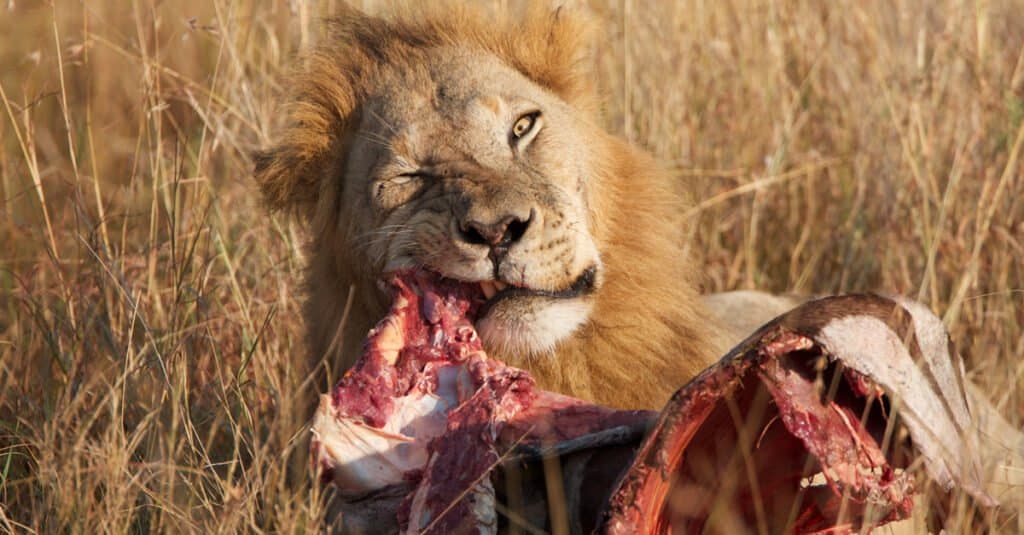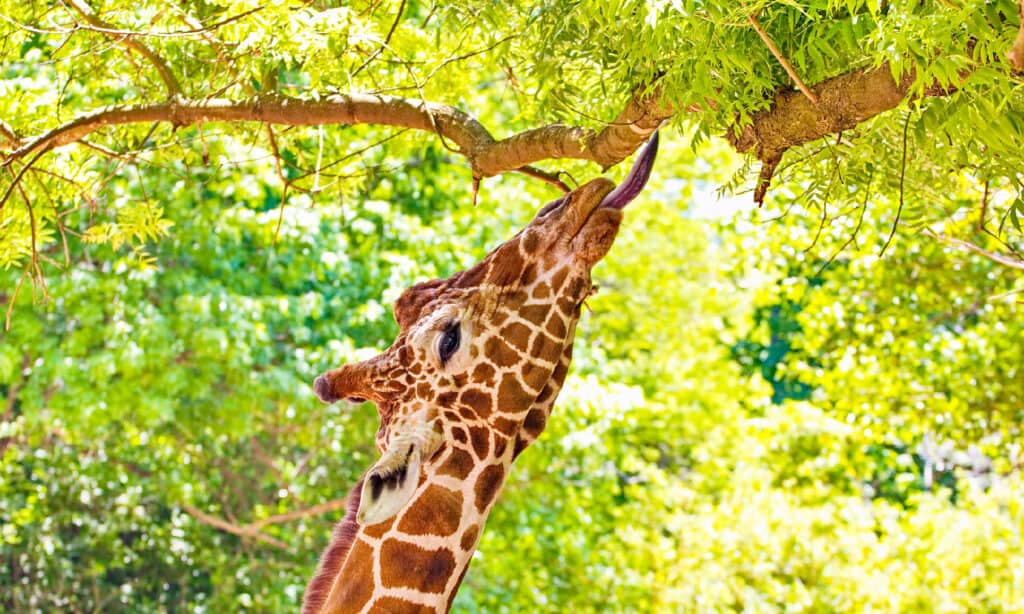Animals are found throughout the world. They soar through the skies, swim in the oceans, and run on the ground. Animals cannot participate in all these feats without energy. Unlike plants that can engage in photosynthesis to obtain energy, animals need to power their bodies by eating food. So, what do animals eat? We’ll show you how animals obtain the energy they need to survive in the world and how some animals are different from others.
What Are Animals?
First things first, let’s define animals. Animals are multicellular eukaryotes, and they all belong to the Animalia biological kingdom. Some examples of animals include human beings, dogs, fish, shrimp, and birds. Every one of these beings must consume plants or animals to maintain their bodily functions.

Animals are multicellular eukaryotes, and they all belong to the Animalia biological kingdom.
©Vecton/Shutterstock.com
Why Animals Must Eat
Animals must eat various foods to get the energy they need to survive. The creature consumes the food, breaks it down, and excretes the waste. In humans, the digestive system which includes the mouth, stomach, small intestines, and large intestines breaks down food before excreting it as urine and feces.
More specifically, the digestive system extracts the chemical energy in food to power the body. Humans must eat proteins, carbohydrates, fats, and other compounds to support the body’s needs. All animals have biological needs that must be met if their bodies are to continue carrying out the processes for life to continue.
However, no two species are exactly alike in terms of their dietary requirements. Some species have evolved to survive on very specific foods. For example, giant pandas eat a diet that is almost exclusively made up of bamboo plants rather than a mix of meats and plants like other bears.
What Foods Do Animals Eat?
Animals eat plants, animals, or some of both. Creatures are broken down into groups based on their eating habits. They can either be carnivores, herbivores, or omnivores. These groups of animals can be broken down into even smaller groups. We’re going to explore each of these and answer your questions about what animals eat in greater detail.
What Do Carnivores Eat?
Carnivores are the meat-eaters of the animal kingdom, and they rely on consuming other animals to get their energy. All or most of their diet comes from the tissue of other animals. That means that the animal has to hunt down and kill other creatures to sustain itself.
Oftentimes, these creatures have features that aid them in hunting other animals. For example, lions have large, pointed teeth or a bird will have a sharp beak that helps them tear flesh and meat from their prey. They’ll usually have a less complicated digestive tract that doesn’t need several chambers for breaking down plant matter. Also, their eyes are usually situated on the front of their heads to help them hunt their prey.
Examples of carnivores include:
- Lions
- Cougars
- Housecats
- Bears
- Tigers
- Hyenas
- Leopards
- Eagles
- Spiders
Not all carnivores are the same, though. Many carnivorous creatures do not only eat meat. Grizzly bears eat a wide variety of plant matter as well as meat, with less than a quarter of their diet coming from the animals they hunt.
Hypercarnivores are animals with a diet that is 70% or more meat. For example, crocodiles and lions are hypercarnivores that mostly eat meat to survive. Scavengers are another type of carnivore that subsist on the flesh of dead animals. Vultures and hyenas are two types of creatures renowned for this behavior.
As you can see, carnivores are diverse in the amount of meat that makes up their diet. Few creatures are obligate carnivores and must eat meat for specific nutrients to survive.

Hypercarnivores are animals with a diet that is 70% or more meat. For example, crocodiles and lions are hypercarnivores that mostly eat meat to survive.
©Richard Damian Knight/Shutterstock.com
What Do Herbivores Eat?
Herbivores eat plants. All or most of their diet is based on plant matter such as vegetables, bark, grass, or fruit. Some herbivores are incredibly small, like some types of krill, eating tiny phytoplankton in the ocean to survive. Others are very large, like the African elephant.
These animals can harvest the carbohydrates that are made by plants through photosynthesis.
Like carnivores, herbivores have some features that are common across various species. Many of them have flat, wide teeth that help them grind plant matter apart so it’s easier for their bodies to break down.
Also, some herbivores have multichambered stomachs and longer digestive tracts to help them break down tough plant matter and draw out the energy they need to survive. An example of both of these features is cattle and sheep, creatures that are referred to as ruminants.
Some examples of herbivores include:
- Elk
- Buffalo
- Giraffes
- Camels
- Honey bees
- Grasshoppers
Herbivores come in many shapes and sizes, and they can often spend a large portion of their waking hours feeding on plants to get the energy required to live.

Herbivores eat plants. All or most of their diet is based on plant matter such as vegetables, bark, grass, or fruit.
©iStock.com/Simplyphotos
What Do Omnivores Eat?
Omnivores eat both animal and plant matter. More specifically, omnivores can survive while eating either. A great number of creatures are omnivorous to some extent, even if they seem like they wouldn’t be.
For example, grizzly bears are omnivorous even though they can hunt down and kill large animals. Omnivores evolved with an advantage in the sense that they can survive when one type of food is scarce compared to the other. Squirrels will eat eggs and insects to survive if they do not have access to fruits and other sorts of food.
Other examples of omnivores include:
- Humans (depending on preferences)
- Pigs
- Chimpanzees
- Seagulls
- Opossums
They have fewer characteristics that help set them apart from other animals but looking at their teeth or mouthparts can help you determine what they are capable of eating. Omnivores will usually have some long, pointed teeth to help them eat meat when it is available as well as flat molars that help them chew plant matter.

Omnivores eat both animal and plant matter. More specifically, omnivores can survive while eating either.
©Billion Photos/Shutterstock.com
Summing Up What Animals Eat
Keep in mind that not all animals fall neatly into a category. Sometimes, a mostly herbivorous creature turns out to be omnivorous. Other times, you’ll find that an omnivore leans to one side more than the other instead of eating equal amounts of plants and animals. For now, just use these reminders the next time you need to know, what do animals eat?
| Carnivores | Herbivores | Omnivores |
|---|---|---|
| Consume Animals | Consume Plants | Consume Animals and Plants |
| Examples Include: – Tigers – Hyenas – Leopards – Eagles – Lions – Cougars – Spiders | Examples Include: – Camels – Honey bees – Grasshoppers – Elk – Buffalo – Giraffes | Examples Include: – Chimpanzees – Seagulls – Opossums – Humans (depending on preferences) – Pigs |
| Known By: – Long, sharp teeth for biting and tearing flesh – Front-facing eyes to help them locate and attack prey – Simple digestive tract | Known By: – Flat teeth for chewing plants – Extra-long digestive tract – May have a multi-chambered stomach to properly digest plant matter | Known By: – Usually have some pointed, sharp teeth to eat meat as well as flat molars to eat plants |
Now that you know what animals eat, you can start discovering more specific niches within the food web. Explore granivores, insectivores, and even frugivores!
Up Next:
- Are Foxes Carnivores Or Omnivores?
- Discover the Largest Carnivorous Plant Species
- What Do Plants Eat? Their Diet Explained
- What Do Sharks Eat? The Top 21 Foods in their Diets!
The photo featured at the top of this post is © iStock.com/miroslav_1
Sources
- Libre Text Biology / The Human Animal, Available here: https://bio.libretexts.org/Bookshelves/Human_Biology/Book%3A_Human_Biology_(Wakim_and_Grewal)/02%3A_Introduction_to_Human_Biology/2.4%3A_The_Human_Animal
- US Department of Health and Human Services, Available here: https://www.niddk.nih.gov/health-information/digestive-diseases/digestive-system-how-it-works#:~:text=The%20hollow%20organs%20that%20make,organs%20of%20the%20digestive%20system.
- National Library of Medicine / Molecular Biology of the Cell. 4th edition., Available here: https://www.ncbi.nlm.nih.gov/books/NBK26882/
- Department of Fisheries and Oceans Canada, Available here: https://www.dfo-mpo.gc.ca/species-especes/profiles-profils/euphausiids-krill-euphausiaces-eng.html
FAQs (Frequently Asked Questions)
What defines an animal?
Animals are multicellular eukaryotes, and they all belong to the Animalia biological kingdom. Some examples of animals include human beings, dogs, fish, shrimp, and birds. Every one of these beings must consume plants or animals to maintain their bodily functions.
What is a hypercarnivore?
Hypercarnivores are animals with a diet that is 70% or more meat. For example, crocodiles and lions are hypercarnivores that mostly eat meat to survive.
Thank you for reading! Have some feedback for us? Contact the AZ Animals editorial team.






